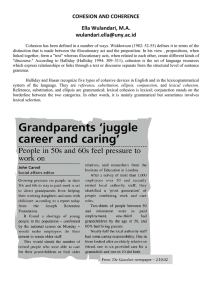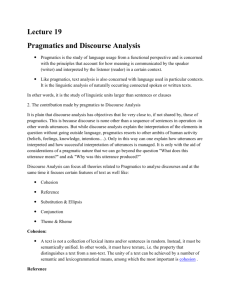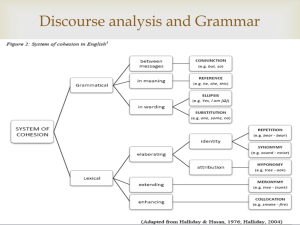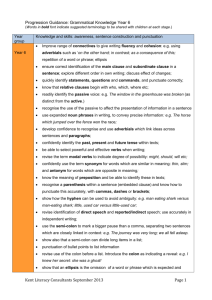Discourse Analysis and Grammar INTRODUCTION
advertisement
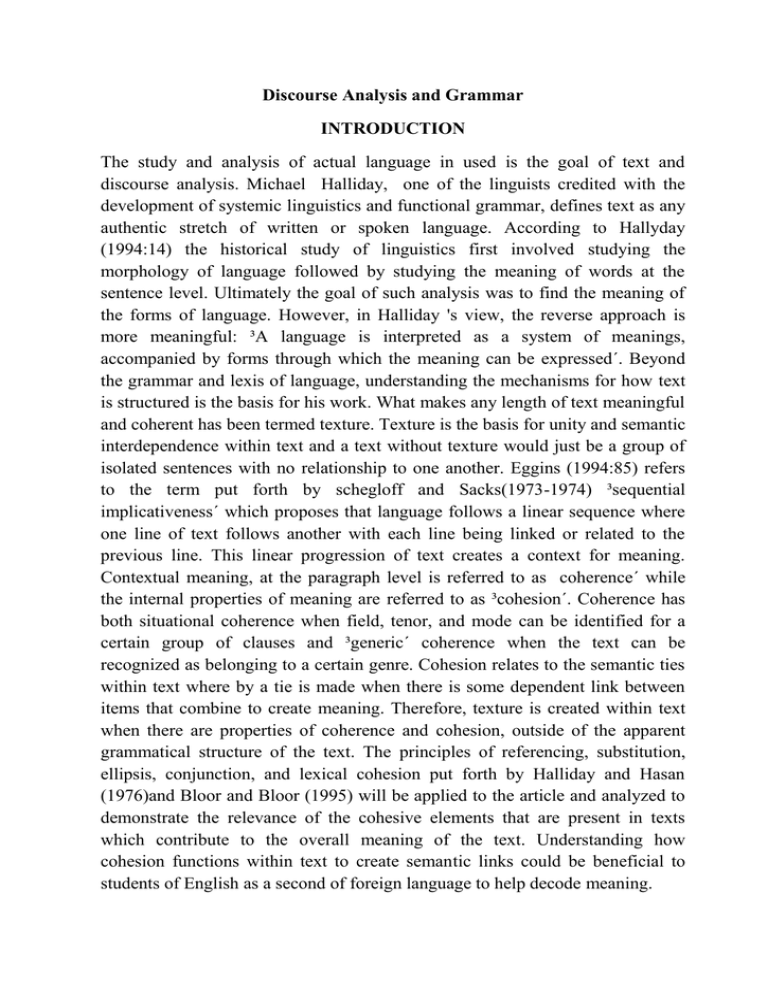
Discourse Analysis and Grammar INTRODUCTION The study and analysis of actual language in used is the goal of text and discourse analysis. Michael Halliday, one of the linguists credited with the development of systemic linguistics and functional grammar, defines text as any authentic stretch of written or spoken language. According to Hallyday (1994:14) the historical study of linguistics first involved studying the morphology of language followed by studying the meaning of words at the sentence level. Ultimately the goal of such analysis was to find the meaning of the forms of language. However, in Halliday 's view, the reverse approach is more meaningful: ³A language is interpreted as a system of meanings, accompanied by forms through which the meaning can be expressed´. Beyond the grammar and lexis of language, understanding the mechanisms for how text is structured is the basis for his work. What makes any length of text meaningful and coherent has been termed texture. Texture is the basis for unity and semantic interdependence within text and a text without texture would just be a group of isolated sentences with no relationship to one another. Eggins (1994:85) refers to the term put forth by schegloff and Sacks(1973-1974) ³sequential implicativeness´ which proposes that language follows a linear sequence where one line of text follows another with each line being linked or related to the previous line. This linear progression of text creates a context for meaning. Contextual meaning, at the paragraph level is referred to as coherence´ while the internal properties of meaning are referred to as ³cohesion´. Coherence has both situational coherence when field, tenor, and mode can be identified for a certain group of clauses and ³generic´ coherence when the text can be recognized as belonging to a certain genre. Cohesion relates to the semantic ties within text where by a tie is made when there is some dependent link between items that combine to create meaning. Therefore, texture is created within text when there are properties of coherence and cohesion, outside of the apparent grammatical structure of the text. The principles of referencing, substitution, ellipsis, conjunction, and lexical cohesion put forth by Halliday and Hasan (1976)and Bloor and Bloor (1995) will be applied to the article and analyzed to demonstrate the relevance of the cohesive elements that are present in texts which contribute to the overall meaning of the text. Understanding how cohesion functions within text to create semantic links could be beneficial to students of English as a second of foreign language to help decode meaning. Principle of Cohesion Structure in text is provided by grammar therefore cohesion is considered to be outside of the structure. Cohesion refers to the non-structural text-forming relations. (Halliday and Hasan1976:7) the concept of cohesion in text is related to semantic ties or relations of meanings that exist within the text, and that define it as a text (ibid:4). Within text, if a previously mentioned item is referred to again and is dependent upon another element, it is considered a tie. Without semantic ties, sentences or utterances would seem to lack any type of relationship to each other and might not be considered text. Halliday and Hasan (ibid:4) refer to this inter textual link as the presupposing and the presupposed. Using the authors' example: Wash and core six cooking apples. Put them into a fireproof dish.´ The word them´ presupposes 'apples´and provides a semantic tie between the two sentences, thus creating cohesion. Cohesion creates interdependency in text. 1.Reference Referencing functions to retrieve presupposed information in text and must be identifiable for it to be considered as cohesive. In written text, referencing indicates how the writer introduces participants and keeps track of them throughout the text. There are three general types of referencing are as follows:1. 1. Exophoric referencing, this refers to information from the immediate context of situation. Example: look at that flower. 2. Endophoric referencing, which refers to information that can be retrieved from within the text? It is this endophoric referencing which is the focus of cohesion theory. Endophoric referencing can be divided into three areas are: a) Anaphoric: Anaphoric refers to any reference that point backwards to previously mentioned information in text. For example: look at the flower. It's so beautiful ( It refers back to the flower) For cohesion purpose, anaphoric referencing is the most relevant as it provides a link with a preceding portion of the text (Halliday and Hasan 1976:51). Functional speaking, there are three main types of cohesive references, they are: 1. Person: Person reference keeps track of function through the speech situation using noun pronouns like : He, him, she, her, etc´. And possessive determiners like³ : mine, yours, his, hers, etc´. For example: Petter has many books. Those books are his 2. Demonstrative Demonstrative reference keeps of information through location using proximity references like ³ this, these, that, those, here, there, then, and the.´ For example: This is my book. I bought it yesterday. 3. Comparative: Comparative reference keeps track of identity and similarity through indirect references using adjectives like : same, equal, similar, different, else, better, more. And adverbs like : so, such, similarly, otherwise, so, more, etc.´ For example: Jack has a white shirt. I bought the same shirt with him. b) Cataphoric: Cataphoric refers to any reference that point forward to information that will be presented later in the text.For example: It's so beautiful, the flower.(It refers forward to the flower) c) Esphoric :Esophoric refers to any reference within the same nominal group or phrase which follows the presupposed item. For example: a few numbers of students get good score. 2. Ellipsis and Substitution Whereas referencing functions to link semantic meanings within text, substitution and ellipsis differs in that it operates as a linguistic link at the lexico- grammatical level. In Bloor and Bloor (1995:96), substitution and ellipsis is used when a speaker or writer wishes to avoid the repetition of a lexical item and is able to draw on one of the grammatical resources of the language to replace the item. ´For example: Wealthier Italians whose parents quit farms for the cities in the 60's are coming back. The word 'coming back´ refers to line before in which the elliptical references to the children of farmers are returning to the farms that their parents quit. The three types of classification for substitution and ellipsis that reflect its grammatical function are as follows: 1. Nominal: In nominal substitution, the most typical substitution words are ³ one and ones´and they substitute nouns. For example: This car is mine, but that one is yours. 2.Verbal: In verbal substitution, the most common substitute is the verb 'do' and is sometime used in conjunction with 'so´ as in 'do so´ and substitute verbs. Halliday and Hasan (ibid:125-126) point out that ³do´ often operate with the reference items 'it´ and 'that´ but still have the main function as a verbal substitute because of its grammatical role. For example: You buy a new book and she do too. From: you buy a new book and she buys a new book too. 3.Clause: In clause substitution, an entire clause is substituted and though it may seem to be similar to either nominal or verbal substitution, the difference is the presupposed anaphoric reference. When something in text is being substituted, it follows that the substituted item maintains the same structural function as the presupposed item. Though substitution and ellipsis are similar in their function as the linguistic link for cohesion, ellipsis differs in that it is substitution by zero(ibid: 142). Ellipsis refers to a presupposed anaphoric item although the reference is not through a place-marker like in substitution. The presupposed item is understood through its structural link. As it is a structural link, ellipsis operates through nominal, verbal and clausal levels. Halliday and Hasan further classify ellipsis in systemic linguistic terminology as deictic, enumerative, epithet, classifier, and qualifier. 3. Conjunction Conjunction, as described by Bloor and Bloor (1995:98) acts as a cohesive tie between clause or sections of text in such a way as to demonstrate a meaningful pattern between them, t though Halliday and Hasan (ibid: 227) indicate that conjunction relations are not tied to any particular sequence in the expression. Therefore, amongst the cohesion forming devices within text, conjunction is the least directly identify able relation. Conjunction acts as a semantic cohesive tie within text in four categories, they are: Additive Additive conjunction acts to structurally coordinate or link by adding to the presupposed item and are signaled through ³and, also, too, furthermore, additionally´, etc. additive conjunction may also act to negate the presupposed item and is signaled by ³nor, and «not, either, neither, etc.´ For example: I don't like smoking, and neither does he. (Derived from: I don't like smoking. He doesn't like smoking). Adversative Adversative conjunctions act to indicate ³contrary to expectation´ and are signaled by ³yet, though, only, but, in fact, rather, etc´ For example: Peter is an English students, but he can't speak English. Causal Causal conjunction expresses ³result, reason and purpose´ and is signaled by ³so, then, for, because, for this reason, as a result, in this respect, etc´.For example: She studied match hardly as a result she passed the exam. Temporal The last conjunctive category is temporal and links by signaling sequence or time. Some samples temporal conjunctive signals are ³then, next, after, that, next day, until then, a the same time, at this point, etc´ For example: I get up at 5 o'clock in the morning then taking a bath. E. Theme and Rheme Most learners, when learning the grammar of a foreign language, spend time assimilating the structure of clauses in that language, i.e. where subjects, objects and adverbials are placed in relation to the verb, and what options are available for rearranging the most typical sequences. Discourse analysis are interested in the implications of these different structural options for the creation of text, and as always, it is from the examination of natural data that patterns of use are seen to emerge. Some of the structural options frequently found in natural data are ignored or underplayed in language teaching (especially those found in spoken data, which are often dismissed as degraded or bad style), probably owing to the continued dominance of standards taken from the written code. English is what is often called an SVO'language, in that the declarative clause requires a verb at its centre, a subject before it and any object after it. This is simply a labeling device which enables comparisons to be made with declarative realizations in different languages, some of which will be VSO or SOV languages. This pattern is often recast in English, no least in interrogative structures, where the verbal group is split by the subject (³does she like cats?´), and in cases where the object is brought forward: 1.The Guardian, Joyce reads. (OSV Object-fronted) There are in English a variety of ways in which the basic clause elements of subject, verb, and complement object, adverbial can be rearranged by putting different elements at the beginning of the clause, as illustrated in sentence 1to3 which is as way of bringing different element to the front are called fronting devices. 2.She reads the Guardian, Joyce. S (pronoun) VOS (noun) Right-displaced subject 3.Joyce, she reads the Guardian S (noun) S (pronoun) VO left displaced subject Structures such as sentence 2and3 are far from infrequent in spoken data, but are often for no obvious reason, not presented in books claiming to describe grammatical options for the learner. If we look again at our examples from the point of view of how the information in them is presented, we can see how different options enable us to focus on or highlight certain elements: sentence 1seems to be saying something about the Guardian rather than about Joyce; sentence 2and 3 seem to be telling us something about Joyce. This aboutness is the sort of notion discourse analysis are concerned with for it is a speaker/writer choice made independently of the propositional content of the message; the speaker/writer decides how to stage the information, where to start, so to speak, in presenting the message. In English, what we decide to bring to the front of the clause (by whatever means) is a signal of what is to be understood as the framework within which what we want to say is to be understood. The rest of the clause can then be seen as transmitting what we want to say within this framework. Items brought to front-place in this way we shall call the themes (or topics) of their clauses in what has been called the Prague school of linguistics, the relationship of the theme to the rest of the sentence is viewed as part of communicative dynamism, that is the assessment of the extent to which each element contributes to the development of the communication. Alternatively, the theme can be seen as the point of departure of the message( Halliday 1985:38). For the moment, we shall take as the theme of a clause the subject noun- phrase, or, if this is not initial, then we shall include whatever comes before it. It seems that first position in the clause is important in many of the world's languages, and that creating a theme in the clause is a universal feature, though its realizations may vary from language to language. Concentrating on the themes (or topics) of clauses does not tell us much about the rest of the clause, which may be called the rheme or comment of the clause. In fact, when we look at themes and rhemes together in connected text, we see further patterns emerging we can divide our postcard text into themes and rhemes: Themes (topic ) Rhemes( comment) 1. I 'm sitting here. 2.Outside my window is a big lawn. 3. In the middle of the lawn is a flower bed. 4.The bed was full of daffodils. 5.You 'd love it here. 6.You must come and stay 7.We 've got plenty of room Two different options can be seen to be realized here: (a) the rheme of sentence 3contains an element (the flower bed) which becomes the theme of sentence 4; (b) the theme of sentence 5 is the same as the rheme of sentence 6. CONCLUSION This chapter has taken a selection of grammatical concepts and has attempted to show how discourse analysis has contributed to our understanding of the relationship between local choice within the clause and sentence and the organization of the discourse as a whole. When speakers and writers are producing discourse, they are at the same time as they are busy constructing clause, monitoring the development of the larger discourse, and their choices at the local level can be seen simultaneously to reflect the concerns of the discourse as an unfolding production, with an audience, whether present or projected. A discourse-oriented approach to grammar would suggest not only a grater emphasis on contexts larger than the sentence, but also a reassessment of priorities in terms of what is taught about such things as word order, articles ,ellipsis, tense and aspect, and some of the other categories discussed here. If grammar is seen to have a direct role in welding clauses, turns and sentences into discourse, what of words themselves? What role does vocabulary choice play in the discourse process? It is to this question that we turn next. Answer question 1.Which sentence is including anaphoric referencing? A . If you couldn't, I would like you to be back here at five thirty b. Look at the flower. It's so beautiful c. Look at that d. I had left my cattle 2.There are three types of classification for ellipsis and substitution that reflect its grammatical function. Except a. Nominal b. Verbal c. Homophoric d. Clausal 3.Which sentence is including comparative reference? a. It's so beautiful, the flower b. This car is mine, but that one is yours. c. I am very satisfied with it. d. Jack has white shirt. I bought the same shirt with him 4. Ellipsis is the omission of elements normally required by the grammar which the speaker/writer assumes are obvious from the context and therefore need not be raised. Based on the definition above, it refers to: a. Ellipsis b. Conjunction c. Clausal d. Reference 5.There are three main types of cohesive references except: a. Personal b. Demonstrative c. Comparative d. Cataphoric Answer key 1.B. look at the flower. It's so beautiful 2.C. Homophoric 3.D. Jack has white shirt. I bought the same shirt with him 4.A. Ellipsis 5.D. Cataphoric
